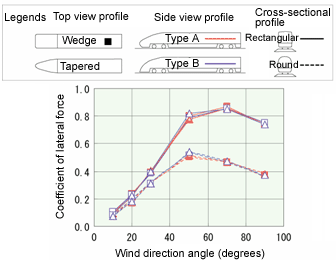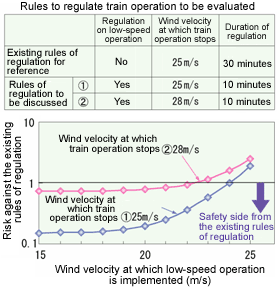|
The aerodynamic characteristics of the head car at different wind direction angles largely govern the threshold wind velocity at which vehicles overturn in high-speed train operation. The RTRI has therefore performed wind tunnel tests to investigate how the profile of the head car affects the coefficient of its aerodynamic force. Results showed that the coefficient of lateral force depends on the head car profile in cars with the same side area at a length of about 5m, irrespective of the nose profile (Fig. 1). The coefficient was also found to be smaller (i.e. advantageous for side winds) when the cross-sectional profile of the head car is rectangular rather than round.
To study the effect of windbreak fences on the bridges and embankments of narrow-gauge lines (where the aerodynamic forces working on rolling stock tend to be higher), the RTRI also performed wind tunnel tests on windbreak fences of different heights installed at different solidity ratios. It was shown that, when windbreak fences of 2m or higher are installed on a bridge or an embankment, the coefficient of lateral force decreases at a constant rate as the installation solidity ratio increases.
To quantitatively describe the safety of train operation at different values of regulated wind velocity and time length, the RTRI proposed a method of evaluating safety using the threshold wind velocity at which vehicles overturn and the regulated wind velocity as parameters. If low-speed train operation is implemented to ensure safety (extending the train operation time), it is possible by this method to determine a trade-off point between a) increases in the effect of the threshold wind velocity at which vehicles overturn and b) the possibility of a strong wind blowing during the extended time zone of train operation. Discussions based on wind observation data (Fig. 2) show cases where safety can be maintained at the present level by setting the train speed and the regulated wind velocity at appropriate values, even when the wind velocity at which train operation stops is set higher and the time length of regulation is shortened.

Fig. 1 Coefficient of lateral force of the head car (results of wind tunnel tests) | 
Fig. 2 A case of quantitative safety evaluation (evaluation of the effect of low-speed operation) |
HOME > Major Results of Research and Development in Fiscal 2004 > I Safety/Reliability

RTRI HOME
Copyright(c) 2005 Railway Technical Research Institute,Tokyo Japan, All rights reserved.
|

